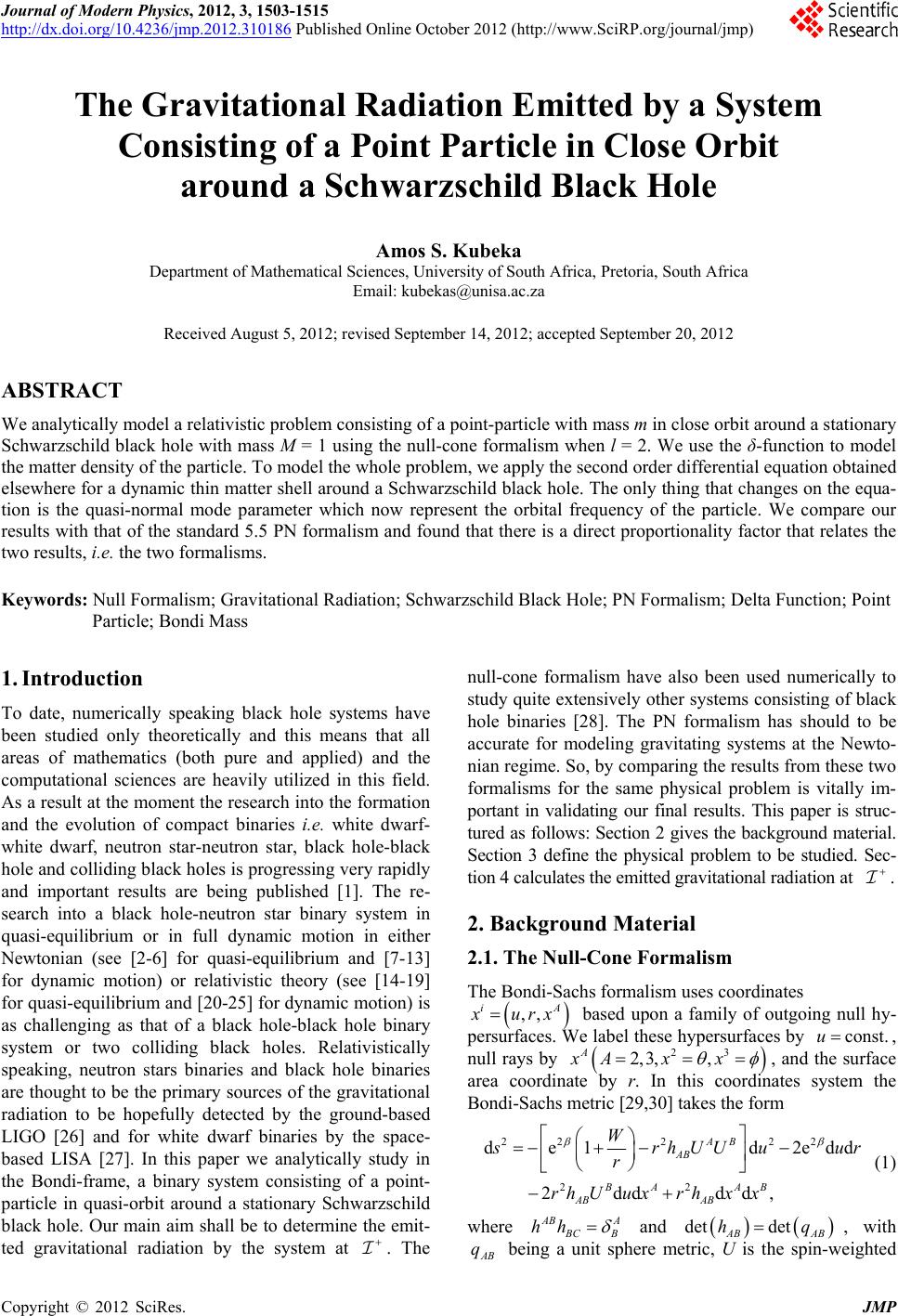 Journal of Modern Physics, 2012, 3, 1503-1515 http://dx.doi.org/10.4236/jmp.2012.310186 Published Online October 2012 (http://www.SciRP.org/journal/jmp) The Gravitational Radiation Emitted by a System Consisting of a Point Particle in Close Orbit around a Schwarzschild Black Hole Amos S. Kubeka Department of Mathematical Sciences, University of South Africa, Pretoria, South Africa Email: kubekas@unisa.ac.za Received August 5, 2012; revised September 14, 2012; accepted September 20, 2012 ABSTRACT We analytically model a relativistic problem consisting of a point-particle with mass m in close orbit around a stationary Schwarzschild black hole with mass M = 1 using the null-cone formalism when l = 2. We use the δ-function to model the matter density of the particle. To model the whole problem, we apply the second order differential equation obtained elsewhere for a dynamic thin matter shell around a Schwarzschild black hole. The only thing that changes on the equa- tion is the quasi-normal mode parameter which now represent the orbital frequency of the particle. We compare our results with that of the standard 5.5 PN formalism and found that there is a direct proportionality factor that relates the two results, i.e. the two formalisms. Keywords: Null Formalism; Gravitational Radiation; Schwarzschild Black Hole; PN Formalism; Delta Function; Point Particle; Bondi Mass 1. Introduction To date, numerically speaking black hole systems have been studied only theoretically and this means that all areas of mathematics (both pure and applied) and the computational sciences are heavily utilized in this field. As a result at the moment the research into the formation and the evolution of compact binaries i.e. white dwarf- white dwarf, neutron star-neutron star, black hole-black hole and colliding black holes is progressing very rapidly and important results are being published [1]. The re- search into a black hole-neutron star binary system in quasi-equilibrium or in full dynamic motion in either Newtonian (see [2-6] for quasi-equilibrium and [7-13] for dynamic motion) or relativistic theory (see [14-19] for quasi-equilibrium and [20-25] for dynamic motion) is as challenging as that of a black hole-black hole binary system or two colliding black holes. Relativistically speaking, neutron stars binaries and black hole binaries are thought to be the primary sources of the gravitational radiation to be hopefully detected by the ground-based LIGO [26] and for white dwarf binaries by the space- based LISA [27]. In this paper we analytically study in the Bondi-frame, a binary system consisting of a point- particle in quasi-orbit around a stationary Schwarzschild black hole. Our main aim shall be to determine the emit- ted gravitational radiation by the system at . The null-cone formalism have also been used numerically to study quite extensively other systems consisting of black hole binaries [28]. The PN formalism has should to be accurate for modeling gravitating systems at the Newto- nian regime. So, by comparing the results from these two formalisms for the same physical problem is vitally im- portant in validating our final results. This paper is struc- tured as follows: Section 2 gives the background material. Section 3 define the physical problem to be studied. Sec- tion 4 calculates the emitted gravitational radiation at . 2. Background Material 2.1. The Null-Cone Formalism The Bondi-Sachs formalism uses coordinates ,, iA urx const.u based upon a family of outgoing null hy- persurfaces. We label these hypersurfaces by , null rays by 23 2, 3,, A xAx x , and the surface area coordinate by r. In this coordinates system the Bondi-Sachs metric [29,30] takes the form 22 222 22 de1 d2edd 2dd dd, AB AB BA AB AB AB Wrh UUuur r rh Uuxrhx x AB A (1) where CB hh det dethq AB q and ABAB , with being a unit sphere metric, U is the spin-weighted C opyright © 2012 SciRes. JMP 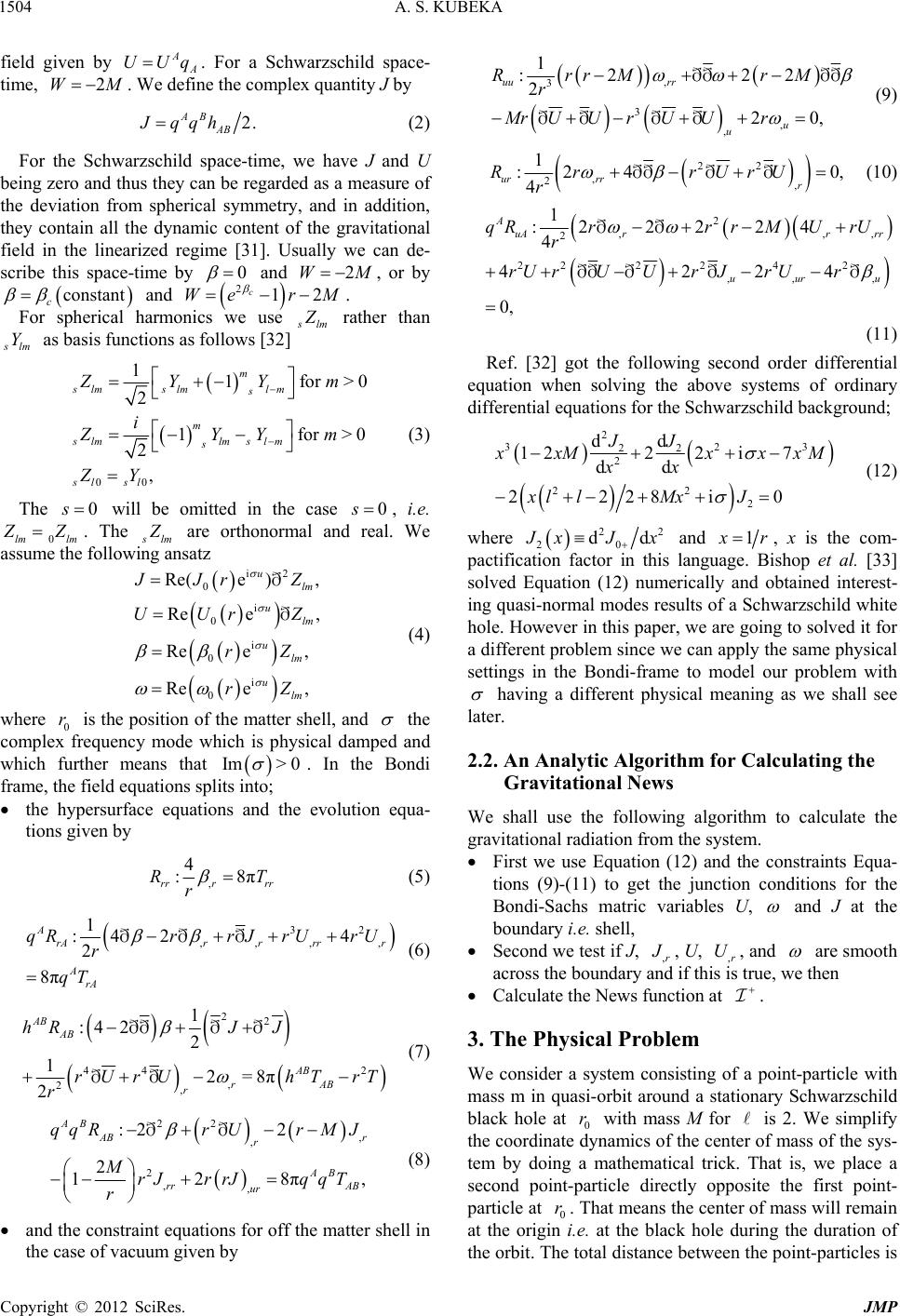 A. S. KUBEKA 1504 field given by A UU . For a Schwarzschild space- time, . We define the complex quantity J by Aq M2W 2. AB AB qqhJ (2) For the Schwarzschild space-time, we have J and U being zero and thus they can be regarded as a measure of the deviation from spherical symmetry, and in addition, they contain all the dynamic content of the gravitational field in the linearized regime [31]. Usually we can de- scribe this space-time by 0 an 2c We d , or by and . 2WM 12rM antcon st c For spherical harmonics we use lm rather than lm Y as basis functions as follows [32] 00 1 2 1 2 , m 1f or>0 for>0 m slmlm s m mlm slm s sl ZYYm i ZYYm ZY 0 s sl sl sl 0s (3) The will be omitted in the case , i.e. 0lm lm Z. The lm are orthonormal and real. We assume the following ansatz i2 i i i e ), e , e , e , u lm u lm u lm u lm 0 0 0 0 Re( Re Re Re Jr UU Z r Z rZ rZ (4) where 0 is the position of the matter shell, and r the complex frequency mode which is physical damped and which further means that Im. In the Bondi frame, the field equations splits into; > 0 the hypersurface equations and the evolution equa- tions given by , 4 :8π r rr RT r rr (5) 32 , , :4 2 4 r r rrr rrJ rUrU ,, 1 2 8π A rA A rA qR r qT (6) 22 44 2 , , 1 22 2=8πAB rA B r J J rUrUhT rT 2 :4 1 2 AB AB hR r (7) , 2 ,, 2 12 AB r rr ur MrJ rrJ r 22 , :2 2 8π, AB r AB AB qqRrUrMJ qqT (8) and the constraint equations for off the matter shell in the case of vacuum given by , 3 3 , , 1 :2 22 2 20, uu rr u u RrrM rM r MrU Ur U Ur (9) 22 , 2, 1 :2 40, 4 ur rrr Rr rUrU r (10) 2 ,,, 2 222 242 ,, , 1 :222 24 4 4224 0, A uArr rr uuru qRrr rMUrU r rU rUUrJrUr (11) Ref. [32] got the following second order differential equation when solving the above systems of ordinary differential equations for the Schwarzschild background; 2 323 22 2 22 2 dd 1222 i7 d d 2228i0 JJ xMxxx M x x xl lMxJ (12) 22 dd where 20 xJx and 1r, x is the com- pactification factor in this language. Bishop et al. [33] solved Equation (12) numerically and obtained interest- ing quasi-normal modes results of a Schwarzschild white hole. However in this paper, we are going to solved it for a different problem since we can apply the same physical settings in the Bondi-frame to model our problem with having a different physical meaning as we shall see later. 2.2. An Analytic Algorithm for Calculating the Gravitational News We shall use the following algorithm to calculate the gravitational radiation from the system. First we use Equation (12) and the constraints Equa- tions (9)-(11) to get the junction conditions for the Bondi-Sachs matric variables U, and J at the boundary i.e. shell, Second we test if J, ,r , U, ,r U, and are smooth across the boundary and if this is true, we then Calculate the News function at . 3. The Physical Problem We consider a system consisting of a point-particle with mass m in quasi-orbit around a stationary Schwarzschild black hole at 0 with mass M for is 2. We simplify the coordinate dynamics of the center of mass of the sys- tem by doing a mathematical trick. That is, we place a second point-particle directly opposite the first point- particle at 0. That means the center of mass will remain at the origin i.e. at the black hole during the duration of the orbit. The total distance between the point-particles is r r Copyright © 2012 SciRes. JMP 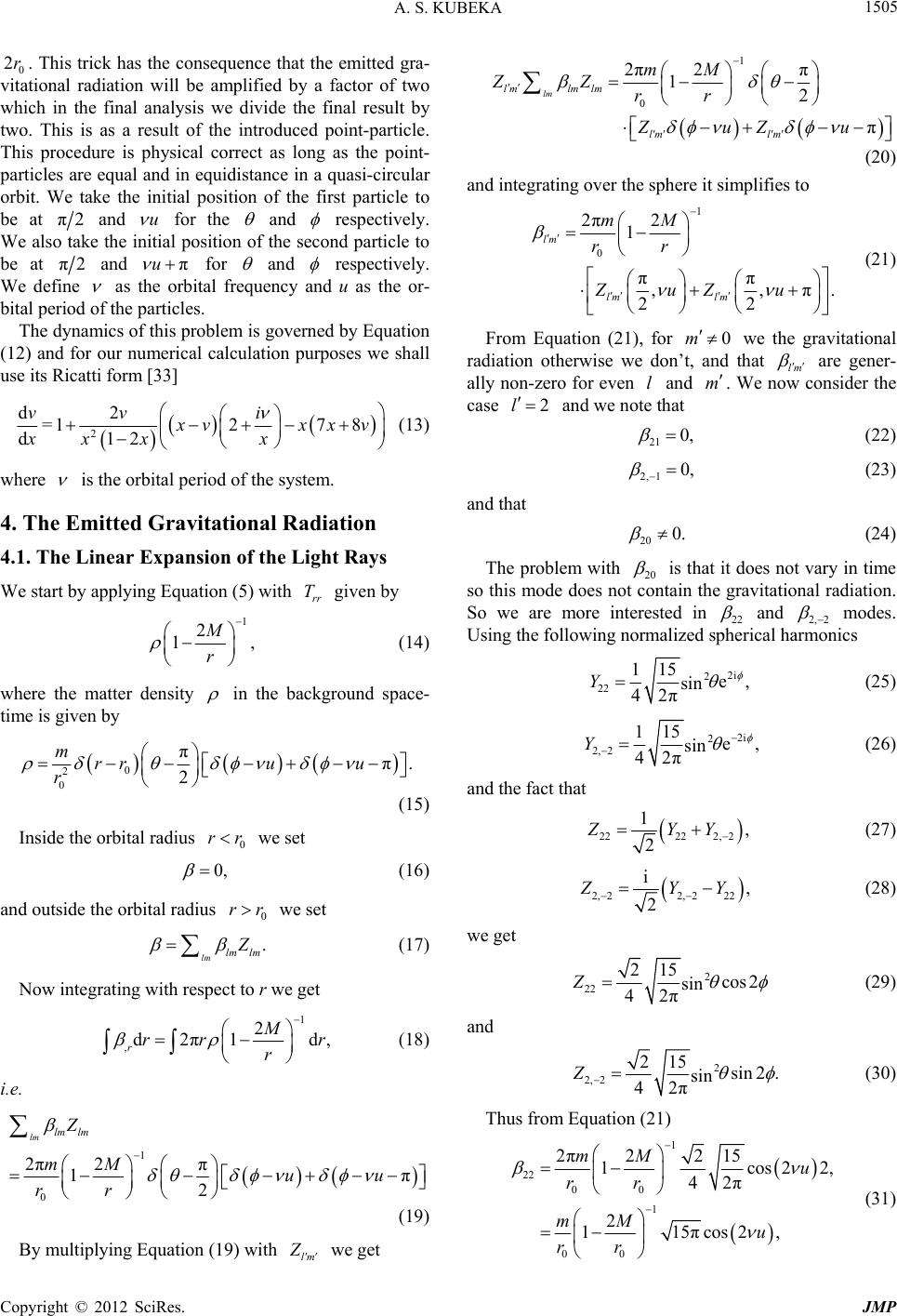 A. S. KUBEKA 1505 0. This trick has the consequence that the emitted gra- vitational radiation will be amplified by a factor of two which in the final analysis we divide the final result by two. This is as a result of the introduced point-particle. This procedure is physical correct as long as the point- particles are equal and in equidistance in a quasi-circular orbit. We take the initial position of the first particle to be at 2r π 1 0 2π2π 12 π lm l mlmlm lm lm mM ZZ rr ZuZu 2 and u for the and respectively. We also take the initial position of the second particle to be at π2 and πu for and respectively. We define as the orbital frequency and u as the or- bital period of the particles. The dynamics of this problem is governed by Equation (12) and for our numerical calculation purposes we shall use its Ricatti form [33] 2 d2 278 d12 vv i =1 vxxv xx xx (13) where is the orbital period of the system. 4. The Emitted Gravitational Radiation 4.1. The Linear Expansion of the Light Rays We start by applying Equation (5) with given by rr T 1 , 2 1 M r (14) where the matter density in the background space- time is given by 0 2 ππ. 2 rru u 0 r 0 m r r (15) Inside the orbital radius we set 0, lm (16) and outside the orbital radius we set 0 rr lmlm . (17) Now integrating with respect to r we get 1 2 1d, Mr r ,d2π rrr (18) i.e. 2 1π lm Z mM uu rr 1 0 2π lm lm π 2 lm (19) By multiplying Equation (19) with we get (20) and integrating over the sphere it simplifies to 1 0 2π2 1 ππ ,,π. 22 lm lm lm mM rr ZuZu (21) 0m From Equation (21), for we the gravitational radiation otherwise we don’t, and that lm are gener- ally non-zero for even and m. We now consider the case l 2l and we note that (22) 21 0, (23) 2, 10, and that (24) 20 0. The problem with 20 is that it does not vary in time so this mode does not contain the gravitational radiation. So we are more interested in 22 and 2, 2 modes. Using the following normalized spherical harmonics 2i 2 22 115 e, sin 42π Y (25) 2i 2 2, 2 115 e, sin 42π Y (26) and the fact that 22222, 2 1, 2 ZYY (27) 2, 22, 222 i, 2 ZYY (28) we get 2 22 215 cos 2 sin 42π Z (29) and 2 2, 2 215 sin 2 sin 42π Z. (30) Thus from Equation (21) 1 22 00 1 00 2π2215 1cos22, 42π 2 115πcos 2, mM u rr mM u rr (31) Copyright © 2012 SciRes. JMP 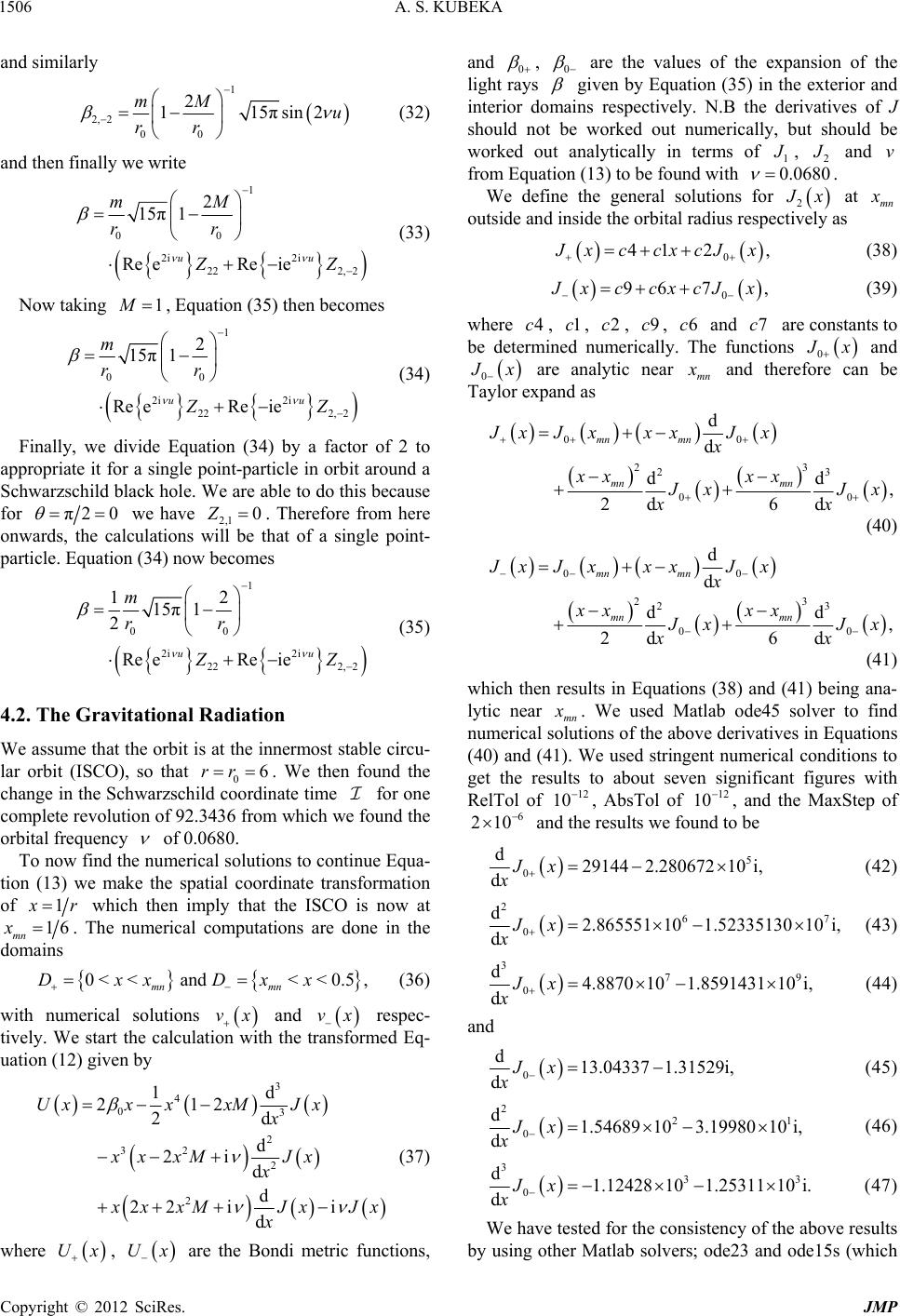 A. S. KUBEKA 1506 and similarly 5πsin2 u 1 2, 2 00 2 11 mM rr (32) and then finally we write 1 00 2i 22 2 15π1 Re eRe mM rr 2i 2, 2 ie uu ZZ 1 (33) Now taking , Equation (35) then becomes 1 00 2i 22 2 15π1 Re eRe m rr 2i 2, 2 ie uu ZZ (34) Finally, we divide Equation (34) by a factor of 2 to appropriate it for a single point-particle in orbit around a Schwarzschild black hole. We are able to do this because for π20 0Z we have 2,1. Therefore from here onwards, the calculations will be that of a single point- particle. Equation (34) now becomes 1 00 2i 22 12 15π1 2 Re eRe m rr 2i 2, 2 ie uu ZZ 6rr (35) 4.2. The Gravitational Radiation We assume that the orbit is at the innermost stable circu- lar orbit (ISCO), so that 0. We then found the change in the Schwarzschild coordinate time for one complete revolution of 92.3436 from which we found the orbital frequency of 0.0680. To now find the numerical solutions to continue Equa- tion (13) we make the spatial coordinate transformation of 1 r which then imply that the ISCO is now at 16x << 0.5, mn xx mn . The numerical computations are done in the domains 0 <<and mn DxxD (36) with numerical solutions vx and respec- tively. We start the calculation with the transformed Eq- uation (12) given by vx i Jx Jx 3 4 03 2 32 2 2 1d 212 2d d 2i d d 22 i d UxxxxM x xx xMx xxMJxJx x Ux (37) where , are the Bondi metric functions, and 0 U , 0 are the values of the expansion of the light rays given by Equation (35) in the exterior and interior domains respectively. N.B the derivatives of J should not be worked out numerically, but should be worked out analytically in terms of 1 , 2 and from Equation (13) to be found with v 0.0680 . We define the general solutions for 2 xmn at outside and inside the orbital radius respectively as 0 41 2, xccxcJx (38) 0 96 7, xccxcJx 4c1c29 , 6 (39) where , , c, ccand 7care constants to be determined numerically. The functions 0 x and 0 x aren analytic near m a nd therefore can be Taylor expand as 00 23 23 00 d d dd , 2d 6d mn mn mn mn JxJ xxxJx x xxxx xJx x (40) 00 23 23 00 d d dd , 2d 6d mn mn mn mn JxJ xxxJ x x xx xx xJx x (41) which then results in Equations (38) and (41) being ana- lytic near mn . We used Matlab ode45 solver to find numerical solutions of the above derivatives in Equations (40) and (41). We used stringent numerical conditions to get the results to about seven significant figures with RelTol of 12 10 , AbsTol of , and the MaxStep of 12 10 6 210 and the results we found to be 5 0 d291442.28067210 i, dJx (42) 2 67 0 d2.865551101.5233513010 i, dJx (43) 3 79 0 d4.8870101.859143110 i, dJx (44) and 0 d13.04337 1.31529i, dJx (45) 2 21 0 d1.54689103.1998010i, dJx (46) 3 33 0 d1.12428101.2531110 i dJx . (47) We have tested for the consistency of the above results by using other Matlab solvers; ode23 and ode15s (which Copyright © 2012 SciRes. JMP 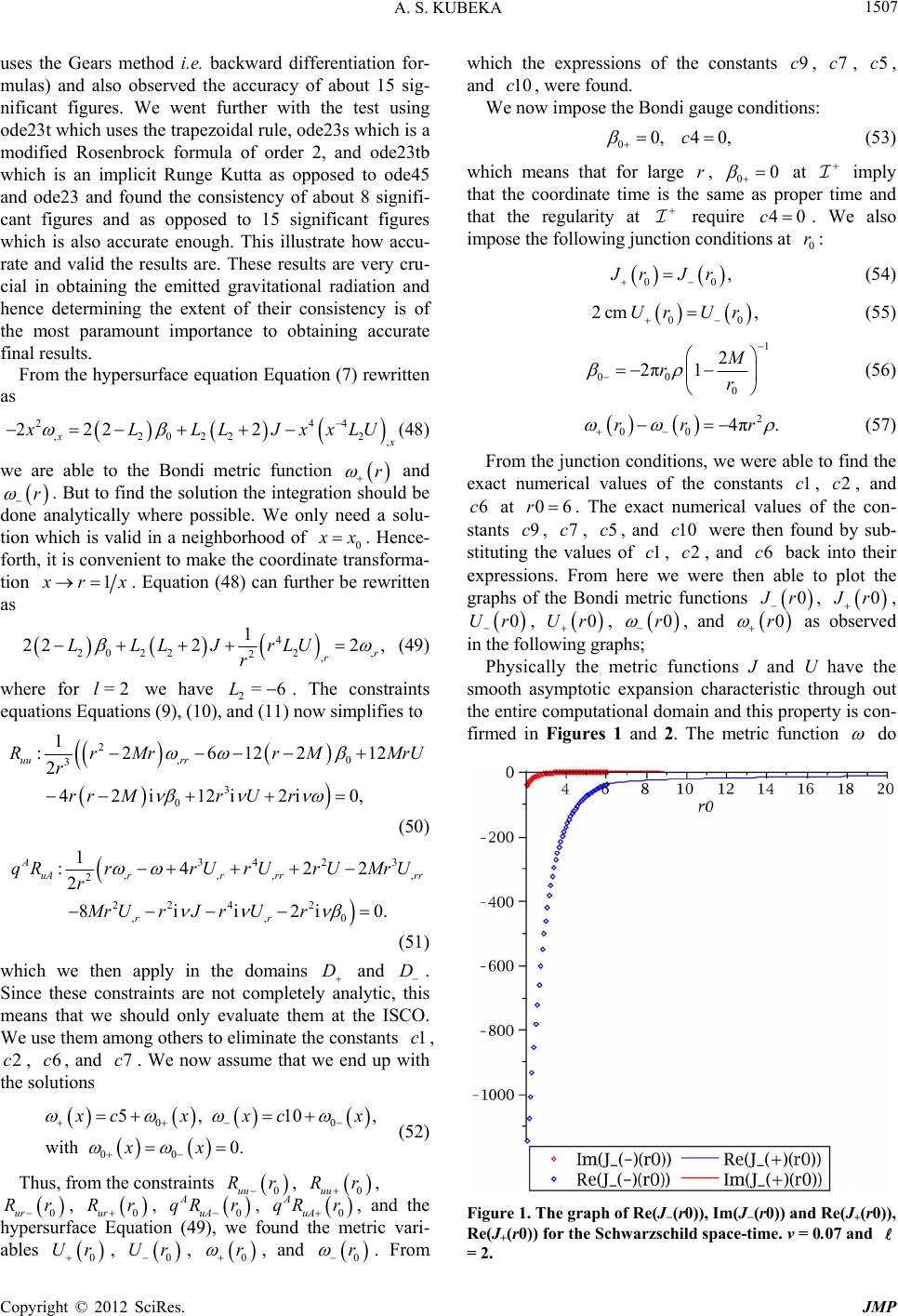 A. S. KUBEKA 1507 uses the Gears method i.e. backward differentiation for- mulas) and also observed the accuracy of about 15 sig- nificant figures. We went further with the test using ode23t which uses the trapezoidal rule, ode23s which is a modified Rosenbrock formula of order 2, and ode23tb which is an implicit Runge Kutta as opposed to ode45 and ode23 and found the consistency of about 8 signifi- cant figures and as opposed to 15 significant figures which is also accurate enough. This illustrate how accu- rate and valid the results are. These results are very cru- cial in obtaining the emitted gravitational radiation and hence determining the extent of their consistency is of the most paramount importance to obtaining accurate final results. From the hypersurface equation Equation (7) rewritten as ,2 022 222 2 x 244 2 , LLL JxxLU (48) we are able to the Bondi metric function r r and . But to find the solution the integration should be done analytically where possible. We only need a solu- tion which is valid in a neighborhood of 0 x. Hence- forth, it is convenient to make the coordinate transforma- tion 1 rx . Equation (48) can further be rewritten as 2 , ,2, r r rLU 4 20 222 1 22 2LLLJ r =6L (49) where for l we have 2. The constraints equations Equations (9), (10), and (11) now simplifies to =2 2 3 3 0 1 :2612 2 42i12i2i uu rr RrMrr M r rrMr Ur ,0 212 0, MrU (50) 34 ,,, 2 22 4 ,, 1 :4 2 8ii A uArr rr rr qRrrU rUr r Mr UrJrUr 2 3 , 2 0 22 2i0. rr U MrU D D (51) which we then apply in the domains and . Since these constraints are not completely analytic, this means that we should only evaluate them at the ISCO. We use them among others to eliminate the constants , , , and . We now assume that we end up with the solutions 1c 6c7c2c 00 10, 00 5, with 0. cxx xx c x 0 r uu Rr (52) Thus, from the constraints , 0, 0ur, ur , uu R R rR 0 r 0 r A qR 0 Ur uA , 0 uA, and the hypersurface Equation (49), we found the metric vari- ables , , A qR r 0 Ur 0 r , and . From which the expressions of the constants c, , , and , were found. 0 r 9 7c5c 10c 00,4 0,c We now impose the Bondi gauge conditions: r0 (53) which means that for large , 0 at imply that the coordinate time is the same as proper time and that the regularity at 40c 0 r require . We also impose the following junction conditions at : 00 , rJr (54) 00 2cm ,Ur Ur (55) 1 00 0 2 2π1M rr (56) 2 00 4πrrr . 1c2c 6c06r (57) From the junction conditions, we were able to find the exact numerical values of the constants , , and at . The exact numerical values of the con- stants , , , and were then found by sub- stituting the values of , , and back into their expressions. From here we were then able to plot the graphs of the Bondi metric functions 9c7c5c10c 1c2c6c 0 0r , r , 0Ur , 0Ur , 0r 0r , and as observed in the following graphs; Physically the metric functions J and U have the smooth asymptotic expansion characteristic through out the entire computational domain and this property is con- firmed in Figures 1 and 2. The metric function do Figure 1. The graph of Re(J−(r0)), Im(J−(r0)) and Re(J+(r0)), Re(J+(r0)) for the Schwarzschild space-time. ν = 0.07 and = 2. Copyright © 2012 SciRes. JMP  A. S. KUBEKA 1508 Figure 2. The graph of Re(U−(r0)), Im(U−(r0)) and Re(U+(r0)), Im(U+(r0)) for the Schwarzschild space-time. ν = 0.07 and = 2. Γ 06r not have this physical property as can be confirmed in Figure 3 but this function is crucial in the calculation procedure of the gravitation radiation in the entire do- main. Physically the function J in the only one that have the time derivative and thus carries the gravitational ra- diation information to calculated at and that all the other Bondi metric functions are intergrated radially from to . The above results indicate that the junction conditions at where implemented correctly and that our numerical methods and the analytical algorithms we implemented to calculating the gravitational radiation worked properly as intended. Then finally, since we are in the Bondi gauge, we found the gravitational news to be 2 2 , lm LlZ 0.2975 im, 2 1Re1iexp i1 2cul (58) which then further simplify to Re0.1889 m (59) with the Bondi mass loss . We compare our results with that of 5.5 PN formalism by Poisson [34] and Sasaki et al. [35] which they found the gravitational ra- diation of the same system like ours with the same physi- cal conditions as in this paper of about Figure 3. The graph of Re(ω−(r0)), Im(ω−(r0)) and Re(ω+(r0)), Im(ω+(r0)) for the Schwarzschild space-time. ν = 0.07 and = 2. 5. Conclusion The work presented here provides us with further future research opportunities to apply the analytic method pre- sented here in the Bondi-frame, to real astrophysics problems involving all sorts of relativistic objects to cal- culate and analyze the emitted gravitational radiation at null infinity. The next step will be to apply this method to a real relativistic astrophysics problem involving a Kerr background. 6. Acknowledgements I would like to thank Professor Nigel Bishop and Dr. Melusi Khumalo for suggesting improvements of the manuscript. I would also like to thank the National Re- search Foundation of South Africa under GUN 2053724 for financial support. REFERENCES [1] K. A. Postnov and L. R. Yungelson, “The Evolution of Compact Binaries Star Systems,” Living Reviews in Rela- tivity, Vol. 9, 2006, p. 6. http://www.livingreviews.org/lrr-2006-6 2 0.0028m 2 0.001 [2] S. Chandrasekhar, “Ellipsoidal Figures of Equilibrium,” Yale University Press, New Heaven, 1969. . From the analysis is seems clear to us that some how there is a factor of about two or three that propositionally relates the two formalisms in studying the gravitational radiation in the newtonian regime. This is fact that still need to be looked at in the near future. [3] L. G. Fishbone, “The Relativistic Roche Problem. I. Equilibrium Theory for a Body in Equatorial, Circular Orbit around a Kerr Black Hole,” Astrophysical Journal, Vol. 185, 1973, pp. 43-68. doi:10.1086/152395 [4] M. Ishii, M. Shibata and Y. Mino, “Black Hole Tidal Copyright © 2012 SciRes. JMP 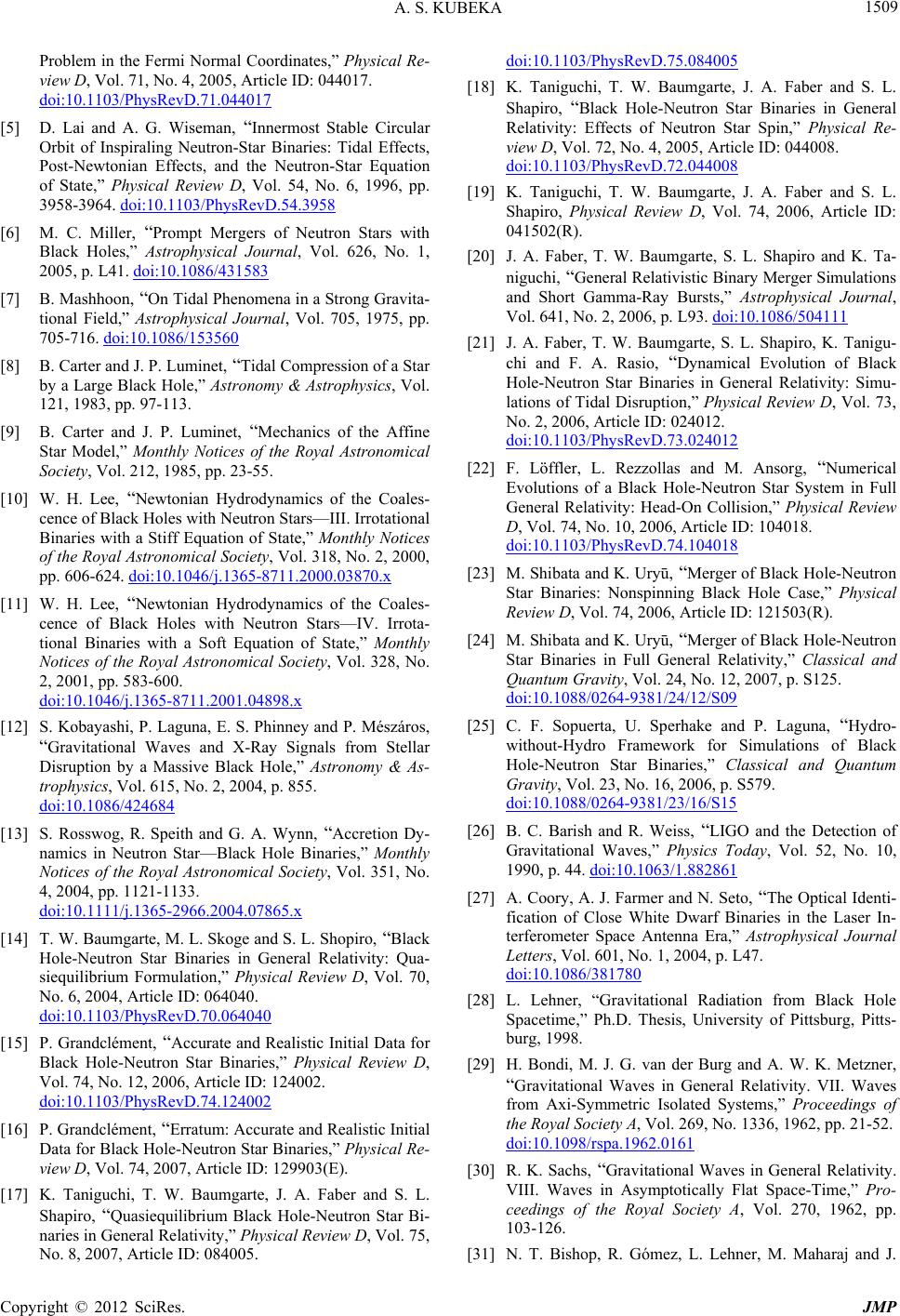 A. S. KUBEKA 1509 Problem in the Fermi Normal Coordinates,” Physical Re- view D, Vol. 71, No. 4, 2005, Article ID: 044017. doi:10.1103/PhysRevD.71.044017 [5] D. Lai and A. G. Wiseman, “Innermost Stable Circular Orbit of Inspiraling Neutron-Star Binaries: Tidal Effects, Post-Newtonian Effects, and the Neutron-Star Equation of State,” Physical Review D, Vol. 54, No. 6, 1996, pp. 3958-3964. doi:10.1103/PhysRevD.54.3958 [6] M. C. Miller, “Prompt Mergers of Neutron Stars with Black Holes,” Astrophysical Journal, Vol. 626, No. 1, 2005, p. L41. doi:10.1086/431583 [7] B. Mashhoon, “On Tidal Phenomena in a Strong Gravita- tional Field,” Astrophysical Journal, Vol. 705, 1975, pp. 705-716. doi:10.1086/153560 [8] B. Carter and J. P. Luminet, “Tidal Compression of a Star by a Large Black Hole,” Astronomy & Astrophysics, Vol. 121, 1983, pp. 97-113. [9] B. Carter and J. P. Luminet, “Mechanics of the Affine Star Model,” Monthly Notices of the Royal Astronomical Society, Vol. 212, 1985, pp. 23-55. [10] W. H. Lee, “Newtonian Hydrodynamics of the Coales- cence of Black Holes with Neutron Stars—III. Irrotational Binaries with a Stiff Equation of State,” Monthly Notices of the Royal Astronomical Society, Vol. 318, No. 2, 2000, pp. 606-624. doi:10.1046/j.1365-8711.2000.03870.x [11] W. H. Lee, “Newtonian Hydrodynamics of the Coales- cence of Black Holes with Neutron Stars—IV. Irrota- tional Binaries with a Soft Equation of State,” Monthly Notices of the Royal Astronomical Society, Vol. 328, No. 2, 2001, pp. 583-600. doi:10.1046/j.1365-8711.2001.04898.x [12] S. Kobayashi, P. Laguna, E. S. Phinney and P. Mészáros, “Gravitational Waves and X-Ray Signals from Stellar Disruption by a Massive Black Hole,” Astronomy & As- trophysics, Vol. 615, No. 2, 2004, p. 855. doi:10.1086/424684 [13] S. Rosswog, R. Speith and G. A. Wynn, “Accretion Dy- namics in Neutron Star—Black Hole Binaries,” Monthly Notices of the Royal Astronomical Society, Vol. 351, No. 4, 2004, pp. 1121-1133. doi:10.1111/j.1365-2966.2004.07865.x [14] T. W. Baumgarte, M. L. Skoge and S. L. Shopiro, “Black Hole-Neutron Star Binaries in General Relativity: Qua- siequilibrium Formulation,” Physical Review D, Vol. 70, No. 6, 2004, Article ID: 064040. doi:10.1103/PhysRevD.70.064040 [15] P. Grandclément, “Accurate and Realistic Initial Data for Black Hole-Neutron Star Binaries,” Physical Review D, Vol. 74, No. 12, 2006, Article ID: 124002. doi:10.1103/PhysRevD.74.124002 [16] P. Grandclément, “Erratum: Accurate and Realistic Initial Data for Black Hole-Neutron Star Binaries,” Physical Re- view D, Vol. 74, 2007, Article ID: 129903(E). [17] K. Taniguchi, T. W. Baumgarte, J. A. Faber and S. L. Shapiro, “Quasiequilibrium Black Hole-Neutron Star Bi- naries in General Relativity,” Physical Review D, Vol. 75, No. 8, 2007, Article ID: 084005. doi:10.1103/PhysRevD.75.084005 [18] K. Taniguchi, T. W. Baumgarte, J. A. Faber and S. L. Shapiro, “Black Hole-Neutron Star Binaries in General Relativity: Effects of Neutron Star Spin,” Physical Re- view D, Vol. 72, No. 4, 2005, Article ID: 044008. doi:10.1103/PhysRevD.72.044008 [19] K. Taniguchi, T. W. Baumgarte, J. A. Faber and S. L. Shapiro, Physical Review D, Vol. 74, 2006, Article ID: 041502(R). [20] J. A. Faber, T. W. Baumgarte, S. L. Shapiro and K. Ta- niguchi, “General Relativistic Binary Merger Simulations and Short Gamma-Ray Bursts,” Astrophysical Journal, Vol. 641, No. 2, 2006, p. L93. doi:10.1086/504111 [21] J. A. Faber, T. W. Baumgarte, S. L. Shapiro, K. Tanigu- chi and F. A. Rasio, “Dynamical Evolution of Black Hole-Neutron Star Binaries in General Relativity: Simu- lations of Tidal Disruption,” Physical Review D, Vol. 73, No. 2, 2006, Article ID: 024012. doi:10.1103/PhysRevD.73.024012 [22] F. Löffler, L. Rezzollas and M. Ansorg, “Numerical Evolutions of a Black Hole-Neutron Star System in Full General Relativity: Head-On Collision,” Physical Review D, Vol. 74, No. 10, 2006, Article ID: 104018. doi:10.1103/PhysRevD.74.104018 [23] M. Shibata and K. Uryū, “Merger of Black Hole-Neutron Star Binaries: Nonspinning Black Hole Case,” Physical Review D, Vol. 74, 2006, Article ID: 121503(R). [24] M. Shibata and K. Uryū, “Merger of Black Hole-Neutron Star Binaries in Full General Relativity,” Classical and Quantum Gravity, Vol. 24, No. 12, 2007, p. S125. doi:10.1088/0264-9381/24/12/S09 [25] C. F. Sopuerta, U. Sperhake and P. Laguna, “Hydro- without-Hydro Framework for Simulations of Black Hole-Neutron Star Binaries,” Classical and Quantum Gravity, Vol. 23, No. 16, 2006, p. S579. doi:10.1088/0264-9381/23/16/S15 [26] B. C. Barish and R. Weiss, “LIGO and the Detection of Gravitational Waves,” Physics Today, Vol. 52, No. 10, 1990, p. 44. doi:10.1063/1.882861 [27] A. Coory, A. J. Farmer and N. Seto, “The Optical Identi- fication of Close White Dwarf Binaries in the Laser In- terferometer Space Antenna Era,” Astrophysical Journal Letters, Vol. 601, No. 1, 2004, p. L47. doi:10.1086/381780 [28] L. Lehner, “Gravitational Radiation from Black Hole Spacetime,” Ph.D. Thesis, University of Pittsburg, Pitts- burg, 1998. [29] H. Bondi, M. J. G. van der Burg and A. W. K. Metzner, “Gravitational Waves in General Relativity. VII. Waves from Axi-Symmetric Isolated Systems,” Proceedings of the Royal Society A, Vol. 269, No. 1336, 1962, pp. 21-52. doi:10.1098/rspa.1962.0161 [30] R. K. Sachs, “Gravitational Waves in General Relativity. VIII. Waves in Asymptotically Flat Space-Time,” Pro- ceedings of the Royal Society A, Vol. 270, 1962, pp. 103-126. [31] N. T. Bishop, R. Gómez, L. Lehner, M. Maharaj and J. Copyright © 2012 SciRes. JMP  A. S. KUBEKA Copyright © 2012 SciRes. JMP 1510 Winicour, “High-Powered Gravitational News,” Physical Review D, Vol. 56, No. 10, 1997, pp. 6298-6309. doi:10.1103/PhysRevD.56.6298 [32] N. T. Bishop, “Linearized Solutions of the Einstein Equa- tions within a Bondi-Sachs Framework, and Implications for Boundary Conditions in Numerical Simulations,” Classical and Quantum Gravity, Vol. 22, No. 12, 2005, p. 2393. doi:10.1088/0264-9381/22/12/006 [33] N. T. Bishop and A. S. Kubeka, “Quasinormal Modes of a Schwarzschild White Hole,” Physical Review D, Vol. 80, No. 6, 2009, Article ID: 064011. doi:10.1103/PhysRevD.80.064011 [34] E. Poisson, “Gravitational Radiation from a Particle in Circular Orbit around a Black Hole. I. Analytical Results for the Nonrotating Case,” Physical Review D, Vol. 47, No. 4, 1993, p. 1497. doi:10.1103/PhysRevD.47.1497 [35] M. Sasaki and H. Tagoshi, “Analytic Black Hole Pertur- bation approach to Gravitational Radiation,” Living Re- views in Relativity, Vol. 6, 2003, p. 6. 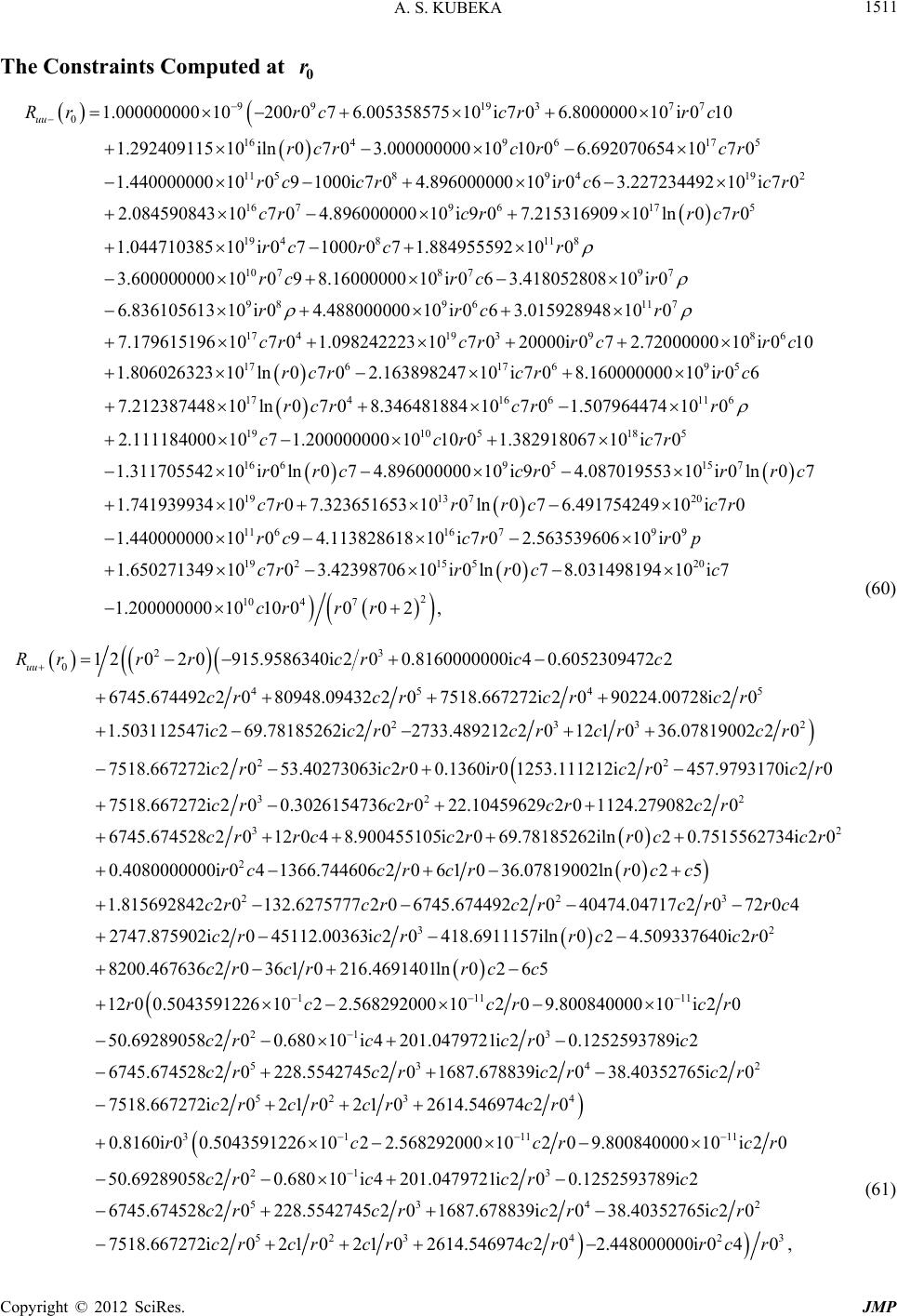 A. S. KUBEKA 1511 The Constraints Computed at 0 r 7 5 10 7 0 c cr 19 2 5 10i 7 0 7 0 ccr cr 8 6 10 i010 r r c 5 6 0 6 0 c r cr 157 0 ln07 7 0 rrc r 991937 0 1649 617 11 5894 1.00000000010200 076.00535857510i 7 06.800000010i 0 1.292409115 10iln0703.000000000 101006.692070654 10 1.440000000 10091000i704.896000000 10i0 uu Rrrccr r rcrcr rc crr 16 79 617 194811 8 10 787 6 3.227234492 2.084590843 10704.896000000 10i907.215316909 10 ln0 1.04471038510i 071000 071.884955592100 3.600000000 10098.16000000 10i063.41805 cr crr rc rcr rc rc 97 98 96117 17 419 39 17 617 280810 i 0 6.83610561310 i 04.48800000010i063.015928948100 7.179615196107 01.098242223107 020000i072.72000000 1.80602632310ln07 02.16389824710i r rrc crcrr c rcrc 69 17416611 1910518 5 16 6 708.16000000010i 7.212387448 10 ln0708.346481884 10701.507964474 10 2.1111840001071.2000000001010 01.38291806710i7 0 1.31170554210i0 ln074.896000000 rr rcrcr ccr rrc 95 1913 720 11 616799 19 2 10 i 904.08701955310i 1.741939934107 07.323651653100ln076.49175424910i 1.440000000 10094.113828618 10i702.563539606 10i0 1.65027134910703.4239 cr crrrcc rccrrp cr 15 520 2 10 47 8706 10i0ln078.031498194 10i 1.2000000001010 0002, rrc crr r 7c (60) 23 0 45 4 233 12020915.9586340i 200.8160000000i 40.6052309472 2 6745.674492 2080948.09432 207518.667272i 2090224.00728i 2 1.503112547i 269.78185262i 202733.489212 20121036.078 uu Rrr rcrcc crcr cr cr ccrcrcr 5 0 2 2 2 20 793170i 20 cr cr 2 2 32 3 1900 7518.667272i 2053.40273063i 200.1360i 01253.111212i 20457.9 7518.667272i 200.3026154736 2 022.10459629 2 01124.279082 20 6745.674528 2012 0 48.900455105i 2 0 crcr rcr crcrcrc r cr rccr 2 3 62734i 2 0 72 0 4 cr rc 2 22 69.78185262iln02 0.75155 0.4080000000i041366.7446062061036.07819002ln025 1.815692842 2 0132.6275777 2 06745.674492 2040474.04717 20 2747.875902i 2045112.003 rc rccrcrrc c crcrc rc r cr 32 11 0r 11 1 21 63i 20418.6911157iln024.509337640i 2 8200.4676362036 10216.4691401ln0265 1200.5043591226 1022.568292000 10209.800840000 10i20 50.692890582 00.68010i4 201.04797 crrc c crcrr cc r ccrcr cr c 3 53 4 523 4 31 11 21i 200.1252593789i 2 6745.6745282 0228.55427452 01687.678839i2 038.40352765i2 7518.667272i2 02102102614.5469742 0 0.8160i00.5043591226 1022.568292000 10209.80 cr c cr crcrcr c rcrcrc r rccr 2 0 11 21 3 53 4 523 0840000 10i 50.692890582 00.68010i4 201.0479721i2 00.1252593789i2 6745.6745282 0228.55427452 01687.678839i2 038.40352765i2 7518.667272i202 102 102614.5469742 cr ccrc cr crcrcr c rcrcrc r 2 2 0 0 cr 42 02.448000000i04rc3 0 ,r (61) Copyright © 2012 SciRes. JMP 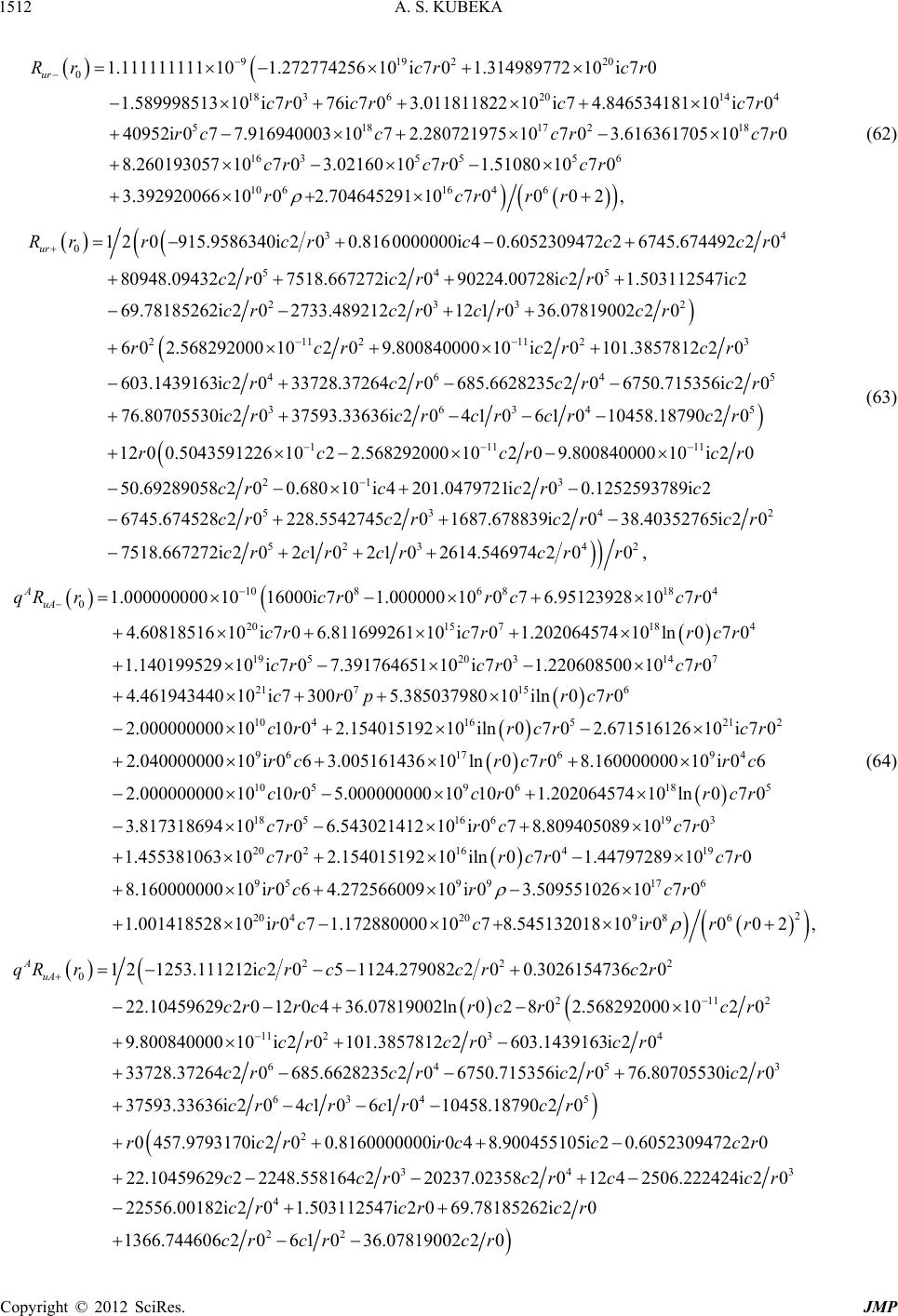 A. S. KUBEKA 1512 919220 0 18 3620 518172 1.111111111101.27277425610i 7 01.31498977210i 70 1.58999851310i 7 076i 703.01181182210i74.846534181 40952i 077.9169400031072.28072197510703.6 ur R rcrcr cr crc rc ccr 14 4 10i 7 0cr 18 051070cr 16 35 55 6 10 61646 163617 8.260193057107 03.02160107 01.510801070 3.3929200661002.70464529110 70002, crcr cr rcrrr (62) 3 0 545 233 120915.9586340i 200.8160000000i 40.6052309472 26745.674 80948.09432 207518.667272i 2090224.00728i 201.5031125 69.78185262i 202733.48921220121036.07819002 ur Rr rcrcc cr cr cr crcrcr 4 492 20 47i 2 cr c 2 2112112 464 3634 20 6 02.56829200010209.80084000010i 20101.3857812 603.1439163i2 033728.372642 0685.66282352 06750.7153 76.80705530i2037593.33636i204106 1010458. cr rcr cr cr cr cr crcrcr cr 3 5 2 0 56i 20 cr cr 5 11 2 0 i 20 2 cr cr c 11 1 21 3 534 18790 1200.5043591226 1022.568292000 10209.800840000 10 50.692890582 00.68010i4 201.0479721i2 00.1252593789i 6745.674528 20228.5542745 201687.678839i 2038. rc cr cr ccr cr crcr 2 765i 20cr 1086 8184 4 7 0 A cr 21 2 i 7 0cr 94 5 i 06 7 0 rc cr 523 42 40352 7518.667272i202 102 102614.546974200,cr crcrcr r (63) 0 20 15 718 19 520 3 1.0000000001016000i 7 01.00000010076.95123928107 0 4.6081851610i 7 06.81169926110i 7 01.20206457410ln0 1.14019952910i 7 07.39176465110i 7 01.22060 uA qRrcrrccr crcrr cr cr 14 7 21 7156 10 4165 9 6176 8500107 0 4.461943440 10 i730005.385037980 10iln070 2.000000000 101002.154015192 10 iln0702.671516126 10 2.040000000 10i063.005161436 10 ln0708.1600000 cr crp rcr crr cr rc rcr 10 59618 18516 6193 20 2164 00 10 2.000000000 101005.000000000 101001.202064574 10ln0 3.817318694107 06.54302141210i 078.8094050891070 1.455381063107 02.15401519210iln07 0 cr crr crrccr crr cr 19 959917 6 20 4209 8 1.44797289 10 8.16000000010i064.27256600910i 03.5095510261070 1.00141852810i 071.1728800001078.54513201810i 0 rc rcr rcc r 2 6 7 0 00 2, cr r r (64) 222 2112 121253.111212i 2051124.279082 200.3026154736 2 0 2 0 A qRrc rccrcr c r 0 11 2 34 22.10459629 2 012 0436.07819002ln02802.56829200010 9.80084000010i 20101.3857812 20603.1439163i 20 33728 uA cr rcr cr cr crcr 6453 634 5 2 .372642 0685.66282352 06750.715356i2 076.807055 37593.33636i2 041061010458.187902 0 0 457.9793170i 200.8160000000i0 48.900455105i 20.605230 22.10459629 222 cr crcr c rcrcrc r rcrrc c c 30i 20 9472 2 0 cr cr 34 4 22 48.558164 2020237.02358 201242506.222 22556.00182i 201.503112547i 2 069.78185262i 20 1366.744606 2061036.07819002 20 crcr c crcr cr cr crcr 3 424i 20cr Copyright © 2012 SciRes. JMP 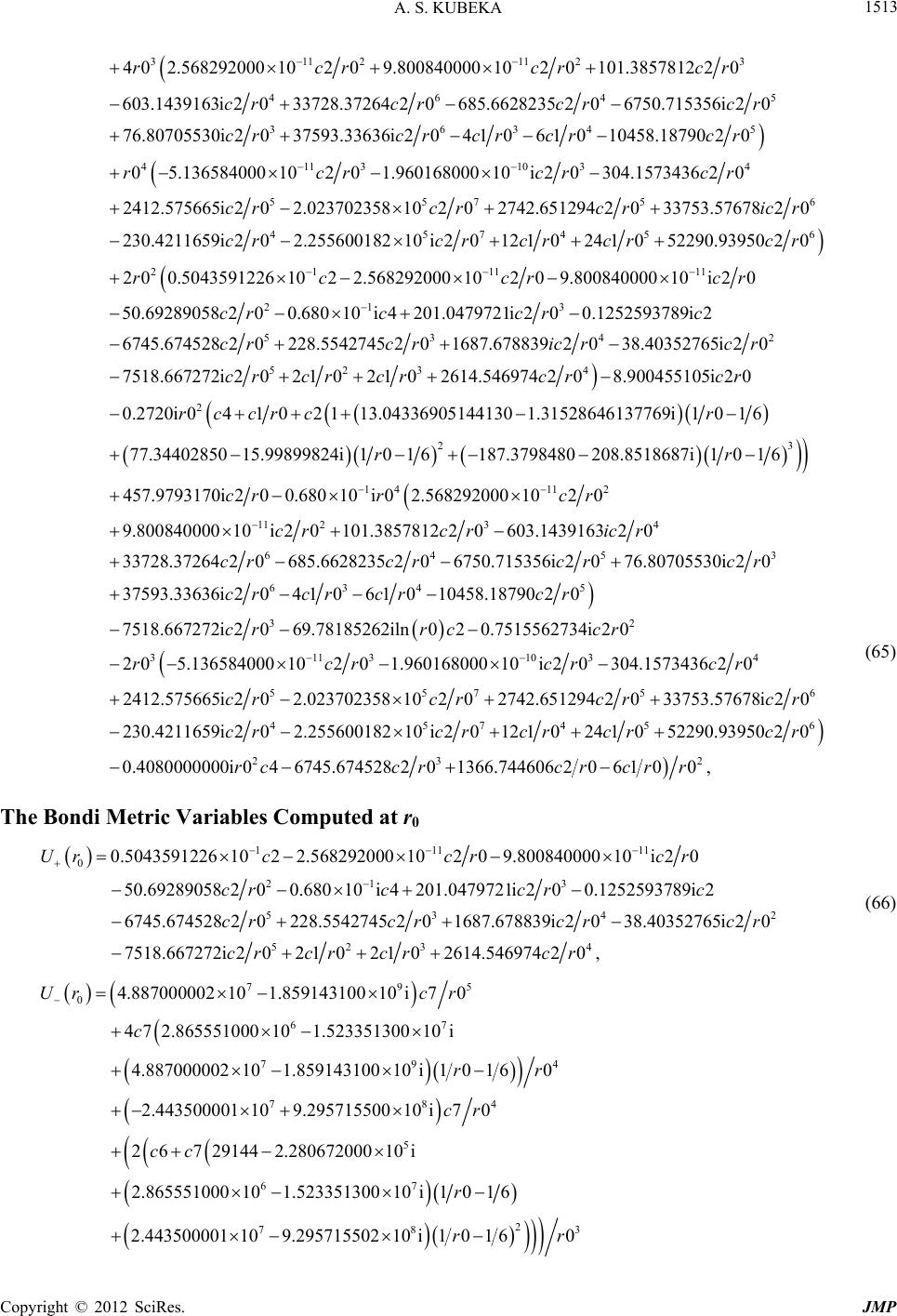 A. S. KUBEKA 1513 3112 112 464 3634 402.568292000 10209.800840000 1020101.38578122 603.1439163i2 033728.372642 0685.66282352 06750.715356i 76.80705530i2037593.33636i204106 1010458.18790 rcr cr cr cr cr crcrcr crc 3 5 0 2 0 cr cr 5 4 6 20 0 7678 20 r cr icr 41 13103 557 5 4574 05.136584000102 01.96016800010i2 0304.15734362 2412.575665i2 02.02370235810 2 02742.6512942 033753.5 230.4211659i202.25560018210 i2012 10241 rcrcr crcr cr crcrcrcr 56 950 20 0 cr cr 21 1111 21 3 53 0 52290.93 200.5043591226 1022.568292000 10209.800840000 10i2 50.69289058 200.68010i 4201.0479721i 200.1252593789i 2 6745.674528 20228.5542745 201687.678839 rc cr cr ccrc crcr i 523 4 2 2 2 038.40352765i 7518.667272i202 102 102614.546974208.900455105i 0.2720i041 02113.04336905144130 1.31528646137769i10 77.34402850 15.99899824i10 16187.37984802 cr cr crcrcr rccrc r r 42 2 0 2 0 1 6 cr cr 3 01 6 2 0 r cr 14 11 2 11 234 64 5 08.8518687i 1 457.9793170i200.680 10i02.568292000 1020 9.80084000010i2 0101.38578122 0603.14391632 0 33728.37264 20685.6628235 206750.715356i 2076.80705530i cr rcr cr cr icr cr crcr 3 4 0cr 634 5 32 3113103 5 37593.33636i204 106 1010458.1879020 7518.667272i 2069.78185262iln020.7515562734i 20 2 05.13658400010201.96016800010i 20304.1573436 2 2412.575665i 202.0237 cr cr crcr crrc cr rcrcr cr 57 5 45745 23 0235810 2 02742.6512942 033753.5 230.4211659i202.25560018210 i2012 10241052290.93 0.4080000000i046745.674528201366.74460620 6100, cr cr crcr crcr rccrcrcr r 6 6 2 7678i 20 950 20 cr cr (65) The Bondi Metric Variables Computed at r0 111 11 4 0 9i 2 52765i r c c 0 21 3 53 0.5043591226 1022.568292000 10209.800840000 10i2 50.692890582 00.68010i4 201.0479721i2 00.125259378 6745.6745282 0228.55427452 01687.678839i2 038.403 Urccrc cr ccr cr crcr 2 20r 523 4 7518.667272i202 102102614.54697420,c rcrcrcr (66) 0 67 79 78 5 472.865551000 101.523351300 10i 4.887000002 101.859143100 10i1 0 2.443500001109.29571550010i70 267291442.28067200010i 2.865551000 c cr cc 795 4 4 4.887000002 101.859143100 10i70 1 60 Ur cr rr 67 78 101.52335130010 i10 2.443500001109.29571550210 i10 r 23 1 6 1 60rr Copyright © 2012 SciRes. JMP 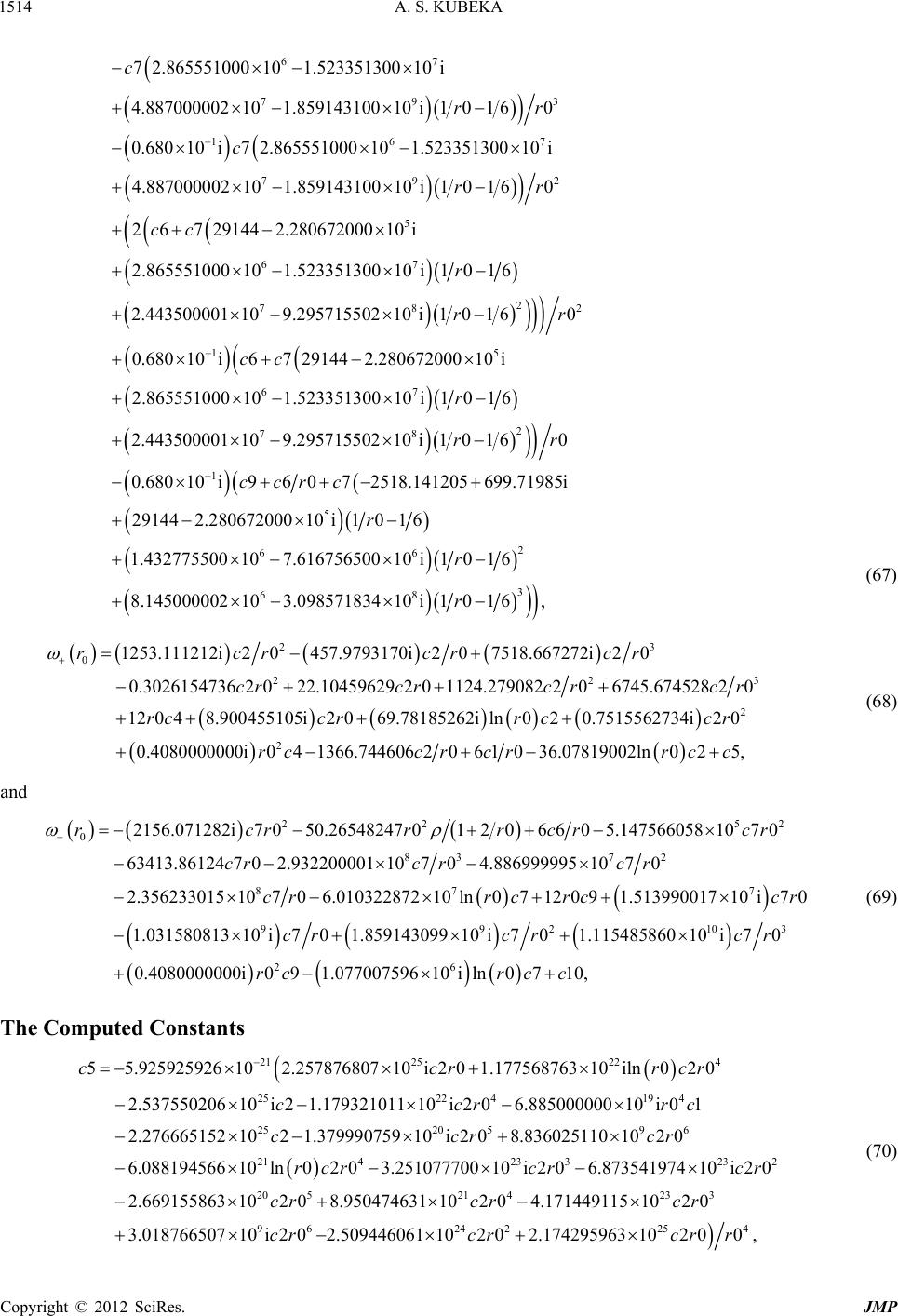 A. S. KUBEKA 1514 67 79 16 79 5 72.865551000 101.523351300 10i 4.887000002 101.859143100 10i10 0.680 10 i72.865551000 101.52335130 4.887000002 101.859143100 10i10 267291442.28067200010i 2.865 c c cc 3 7 2 1 60 010 i 1 60 rr rr 67 78 67 78 551000 101.523351300 10i10 2.443500001109.29571550210 i10 0.68010i67 291442.2806720001 2.865551000 101.523351300 10i10 2.443500001109.29571550210 i10 0.6 r cc r 22 15 2 1 6 1 60 0 i 1 6 1 60 rr rr 2 3 699.71985i 1 6 1 6, 1 5 66 68 8010i9 60 72518.141205 291442.28067200010i101 6 1.432775500 107.616756500 10i10 8.145000002 103.098571834 10i10 ccrc r r r (67) 2 3 0 22 1253.111212i 2 0457.9793170i 207518.667272i 20 0.3026154736 2 022.10459629 2 01124.279082 206745.67 12 0 48.900455105i2 069.78185262iln020.75155627 0.4080000000 rcr cr crcrc r rccrrc 3 2 4528 20 34i2 0 cr c r cr 0 25,rc c 2 i041366.744606206 1036.07819002lnrccr cr (68) and 22 0 83 72 87 2156.071282i7 050.26548247 01206605.147566058 63413.86124 7 02.93220000110704.8869999951070 2.35623301510 7 0 6.01032287210ln0712091.513990017 rcrrrcr cr crcr crr crc 52 7 107 0 10 i70 cr cr 992 26 1.03158081310 i701.85914309910 i701.11548586010 0.4080000000i091.07700759610iln0710, cr cr rcrc c 103 i 70cr (69) The Computed Constants 212522 4 4 6 5 5.92592592610 2.25787680710i201.17756876310iln020 1 ccrrcr rc cr 23 2 3 25 10i 20 2 0 2 cr cr cr 25 22 419 2520 59 2.53755020610i 21.17932101110i 206.88500000010i 0 2.276665152 1021.379990759 10i208.836025110 1020 6 ccr ccr 21423 3 20521 423 96 242 .08819456610ln0203.25107770010i 2 06.873541974 2.669155863102 08.950474631102 04.17144911510 3.01876650710i202.50944606110202.17429596310 rcr cr cr cr cr cr (70) 4 00,r Copyright © 2012 SciRes. JMP 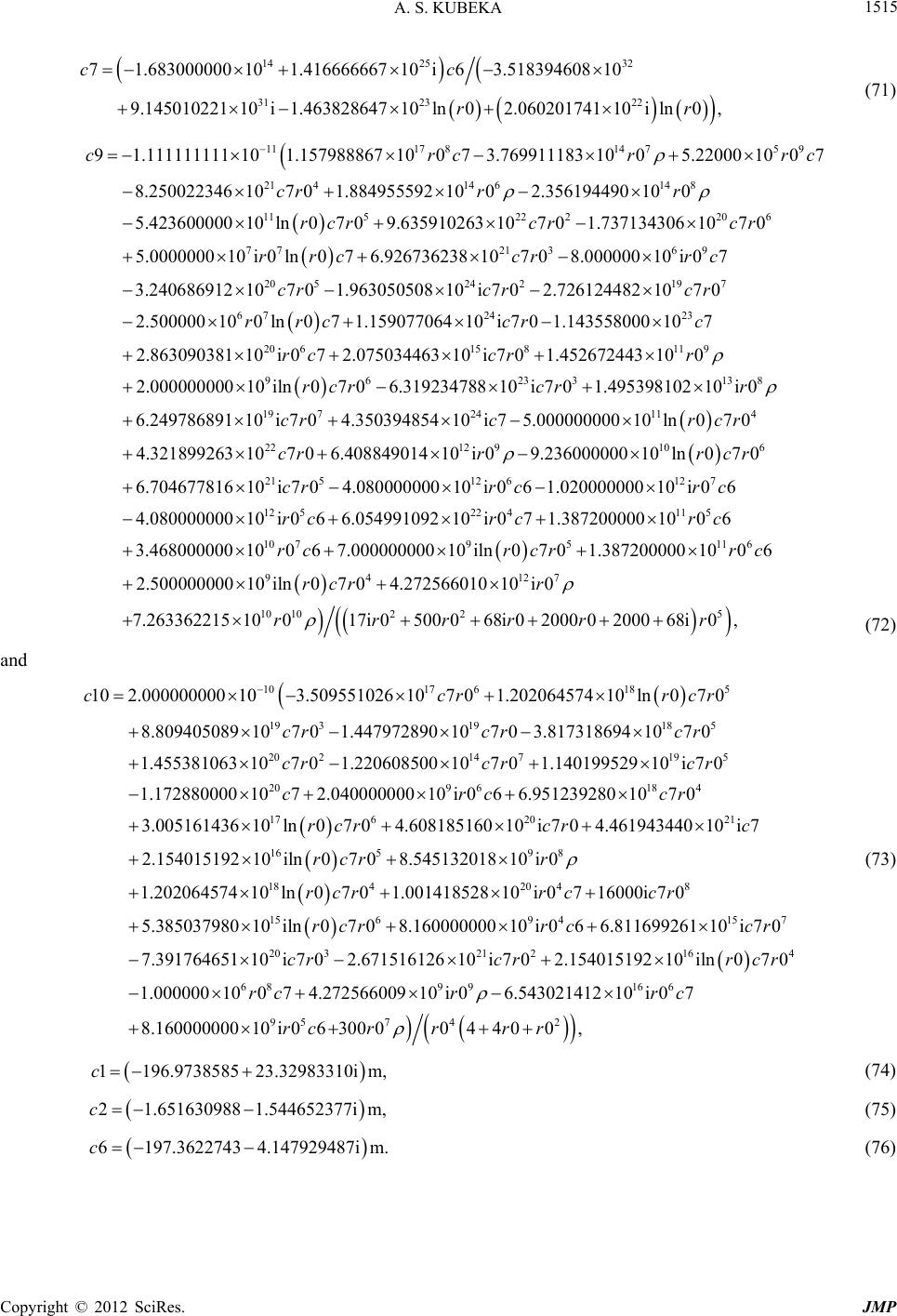 A. S. KUBEKA Copyright © 2012 SciRes. JMP 1515 14 25 31 23 71.683000000101.41666666710i63.518394608 10 9.145010221 10i1.46382864710ln02.060201741 1 cc 32 22 0i ln0,rr 5 9 000 1007rrc 6 7 0cr c 138 i 0r 4 6 7 0 7 0 6 r cr (71) 1117 814 7 21414 614 8 11522 2 91.111111111 101.15798886710073.7699111831005.22 8.250022346 10701.884955592 1002.356194490 100 5.42360000010ln07 09.635910263107 01.73713 crc cr rr rcr cr 20 7721369 20 524219 7 67 24 4306 10 5.000000010 i 0ln076.92673623810708.00000010 i07 3.240686912107 01.96305050810i 7 02.726124482107 0 2.500000 100ln071.159077064 10i701.1435580 rrccr r crcr cr rrc cr 23 20615811 9 96 233 19 724 00 107 2.86309038110i072.075034463 10 i701.452672443 100 2.00000000010iln07 06.31923478810i701.49539810210 6.24978689110i 7 04.35039485410i 75.0000000 c rc cr r rcrcr cr c 11 2212 910 21512612 7 12 522 4 0010 ln0 4.321899263107 06.40884901410i 09.23600000010ln0 6.704677816 10 i704.080000000 10i061.020000000 10 i0 4.08000000010i 066.05499109210i 07 rc cr rr crr cr c rc rc 11 5 10 79511 94 127 10 10225 1.387200000 1006 3.468000000 10067.000000000 10iln0701.387200000 10 2.500000000 10iln0704.272566010 10 i0 7.26336221510017i0500 068i02000 0200068i0 rc rc rcr rcrr rrrrr 6 0 6rc r , 5 5 7 0 0 7 0 rcr r cr5 21 10i 7 cr c 8 15 7 4 10i 7 0 ln07 0 cr r cr (72) and 1017 618 19 31918 20 214 719 102.000000000 103.509551026 10701.202064574 10ln0 8.809405089 10701.447972890 10703.817318694 107 1.455381063107 01.220608500107 01.14019952910i ccr crcr c cr cr 20 9 6184 17 620 16598 18 1.172880000 1072.040000000 10i066.951239280 1070 3.00516143610ln07 04.60818516010i 7 04.461943440 2.15401519210iln0708.54513201810 i0 1.20206457410 ln crc rcr cr rcr r r 4204 1569 4 20 321 216 6 07 01.00141852810i 0716000i 70 5.38503798010iln0708.16000000010 i 066.811699261 7.39176465110i702.671516126 10 i702.154015192 10 i 1.000000 10 crrccr rcr rc cr cr r 899 95742 074.272566009 10i06.543021412 10i07 8.16000000010i06300004400, cr rcrrrr 166 rc 2983310i m, 652377i m, 929487i m (73) 1196.9738585 23.3c 21.651630988 1.544c (74) (75) 6197.3622743 4.147c . (76)
|